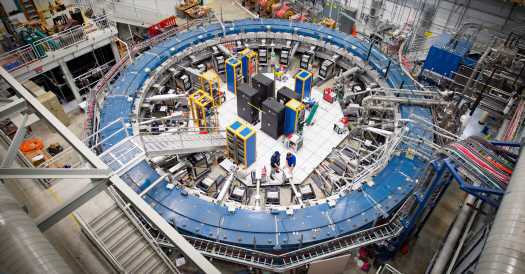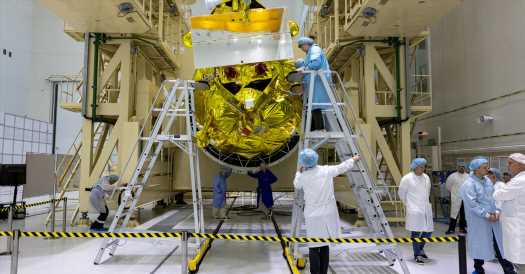On July 24, a large team of researchers convened in Liverpool to unveil a single number related to the behavior of the muon, a subatomic particle that might open a portal to a new physics of our universe.
All eyes were on a computer screen as someone typed in a secret code to release the results. The first number that popped out was met with exasperation: a lot of concerning gasps, oh-my-God’s and what-did-we-do-wrong’s. But after a final calculation, “there was a collective exhale across multiple continents,” said Kevin Pitts, a physicist at Virginia Tech who was five hours away, attending the meeting virtually. The new measurement matched exactly what the physicists had computed two years prior — now with twice the precision.
So comes the latest result from the Muon g-2 Collaboration, which runs an experiment at Fermi National Accelerator Laboratory, or Fermilab, in Batavia, Ill., to study the deviant motion of the muon. The measurement, announced to the public and submitted to the journal Physical Review Letters on Thursday morning, brings physicists one step closer to figuring out if there are more types of matter and energy composing the universe than have been accounted for.
“It really all comes down to that single number,” said Hannah Binney, a physicist at the Massachusetts Institute of Technology’s Lincoln Laboratory who worked on the muon measurement as a graduate student.
Scientists are putting to the test the Standard Model, a grand theory that encompasses all of nature’s known particles and forces. Although the Standard Model has successfully predicted the outcome of countless experiments, physicists have long had a hunch that its framework is incomplete. The theory fails to account for gravity, and it also can’t explain dark matter (the glue holding our universe together), or dark energy (the force pulling it apart).
One of many ways that researchers are looking for physics beyond the Standard Model is by studying muons. As heavier cousins of the electron, muons are unstable, surviving just two-millionths of a second before decaying into lighter particles. They also act like tiny bar magnets: Place a muon in a magnetic field, and it will wobble around like a top. The speed of that motion depends on a property of the muon called the magnetic moment, which physicists abbreviate as g.
In theory, g should exactly equal 2. But physicists know that this value gets ruffled by the “quantum foam” of virtual particles that blip in and out of existence and prevent empty space from being truly empty. These transient particles change the rate of the muon’s wobble. By taking stock of all the forces and particles in the Standard Model, physicists can predict how much g will be offset. They call this deviation g-2.
But if there are unknown particles at play, experimental measurements of g will not match this prediction. “And that’s what makes the muon so exciting to study,” Dr. Binney said. “It’s sensitive to all of the particles that exist, even the ones that we don’t know about yet.” Any difference between theory and experiment, she added, means new physics is on the horizon.
To measure g-2, researchers at Fermilab generated a beam of muons and steered it into a 50-foot-diameter, doughnut-shaped magnet, the inside brimming with virtual particles that were popping into reality. As the muons raced around the ring, detectors along its edge recorded how fast they were wobbling.
Using 40 billion muons — five times as much data as the researchers had in 2021 — the team measured g-2 to be 0.00233184110, a one-tenth of 1 percent deviation from 2. The result has a precision of 0.2 parts per million. That’s like measuring the distance between New York City and Chicago with an uncertainty of only 10 inches, Dr. Pitts said.
“It’s an amazing achievement,” said Alex Keshavarzi, a physicist at the University of Manchester and a member of the Muon g-2 Collaboration. “This is the world’s most precise measurement ever made at a particle accelerator.”
But whether the measured g-2 matches the Standard Model’s prediction has yet to be determined. That’s because theoretical physicists have two methods of computing g-2, based on different ways of accounting for the strong force, which binds together protons and neutrons inside a nucleus.
The traditional calculation relies on 40 years of strong-force measurements taken by experiments around the world. But with this approach, the g-2 prediction is only as good as the data that are used, said Aida El-Khadra, a theoretical physicist at the University of Illinois Urbana-Champaign and a chair of the Muon g-2 Theory Initiative. Experimental limitations in that data, she said, can make this prediction less precise.
A newer technique called a lattice calculation, which uses supercomputers to model the universe as a four-dimensional grid of space-time points, has also emerged. This method does not make use of data at all, Dr. El-Khadra said. There’s just one problem: It generates a g-2 prediction that differs from the traditional approach.
“No one knows why these two are different,” Dr. Keshavarzi said. “They should be exactly the same.”
Compared with the traditional prediction, the latest g-2 measurement has a discrepancy of over 5-sigma, which corresponds to a one in 3.5 million chance that the result is a fluke, Dr. Keshavarzi said, adding that this degree of certainty was beyond the level needed to claim a discovery. (That’s an improvement from their 4.2-sigma result in 2021, and a 3.7-sigma measurement done at Brookhaven National Laboratory near the turn of the century.)
But when they compared it with the lattice prediction, Dr. Keshavarzi said, there was no discrepancy at all.
Rarely in physics does an experiment surpass the theory, but this is one of those times, Dr. Pitts said. “The attention is on the theoretical community,” he added. “The limelight is now on them.”
Dr. Binney said, “We are on the edge of our seats to see how this theory discussion pans out.” Physicists expect to better understand the g-2 prediction by 2025.
While the two camps of theory work it out, experimentalists will hone their g-2 measurement further. They have more than double the amount of data left to sift through, and once that’s included, their precision will improve by another factor of two.
The latest result moves physicists one step closer to a Standard Model showdown. But even if new physics is confirmed to be out there, more work will be needed to figure out what that actually is. The discovery that the known laws of nature are incomplete would lay the foundation for a new generation of experiments, Dr. Keshavarzi said, because it would tell physicists where to look.
For Dr. Pitts, who has spent nearly 30 years pushing the bounds of the Standard Model, proof of new physics would be both a celebratory milestone and a reminder of all that is left to do. “On one hand it’s going to be, Have a toast and celebrate a success, a real breakthrough,” he said. “But then it’s going to be back to work. What are the next ideas that we can get to work on?”
Katrina Miller is a science reporting fellow for The Times. She recently earned her Ph.D. in particle physics from the University of Chicago. More about Katrina Miller
Source: Read Full Article


